#Common Causes of Lithium Battery Explosion
Text
Hoverboard Lithium Batteries Factory Wholesale
The battery is one of the most important part of Hoverboard, and choosing a high-quality Hoverboard battery can greatly improve the usage time and experience.
Like most other electric vehicles, there are a few different types of batteries to consider. If you’re in the process of selecting one of the new hoverboard, then you’ll want to consider what kind of battery you’re getting.
Learn more info. check out here: https://www.redwaypower.com/hoverboard-batteries/
#60V 100Ah Lithium Battery#Lithium Battery Explosion#What Is Lithium Polymer Battery?#Common Causes of Lithium Battery Explosion#Hoverboard Lithium Batteries Factory Wholesale#CCA in a jump starter
0 notes
Text
A 7-year-old boy and a teenager were killed in a fire sparked by an e-bike's lithium-ion battery in New York on Monday, marking the city's fifth fatality in connection with the batteries so far this year, officials said.
Calling the incident a "terrible tragedy," New York City Fire Department Chief John Hodgens said the blaze started in the vestibule of the first floor of a residential building in Queens.
The blaze quickly traveled upstairs, where a father and his children were staying, NBC New York reported. Four people were able to jump out of windows, but two did not survive, Hodgens said in a social media post.
"The way these fires occur, it’s like an explosion of fire. The occupants have very little chance of escaping," Hodgens said.
"We have been talking about this for a couple of years and how dangerous it is to store these devices anywhere near your exit. This bike was right at the front door of the house and the occupants didn’t have a chance to get out of the building,” he said.
The incident comes amid a rise in the number of fires caused by lithium batteries across the United States.
Monday's blaze marked the city's 59th fire and fifth fatality caused by a lithium-ion battery so far this year, Dan Flynn, the department's chief fire marshal, said.
Last month, a lithium-ion battery sparked another fast-moving fire in New York City, leveling a supermarket and neighboring laundromat.
Authorities said an electric mobility device, possibly an e-bike powered by a lithium-ion battery, was to blame for the five-alarm fire.
E-bikes are widely used in high-density cities, especially in New York where the mode of transport is popular for delivery services. The lithium-ion batteries that power them have become an increasingly common feature in transportation, as well as in household products and residential solar energy systems.
When the batteries fail or overheat, however, they can release flammable, toxic gasses that can spark fast-spreading fires that are difficult to extinguish.
“The source of the gasses that are creating the flames is confined within a cell battery that will not allow water in,” Ofodike Ezekoye, a fire scientist and professor of mechanical engineering at the University of Texas at Austin, previously told NBC News. “When firefighters are responding to these types of incidents, it takes a lot longer to be able to control the fire because it requires so much more water.”
With the number of fires caused by lithium batteries rising across the country, firefighters and other experts have warned that the training needed to fight them is lagging in many places, while many users may also not be aware of the risks.
"We want people to use them, but we want people to use them safely," Flynn said following Monday's fire.
The chief fire marshal warned that e-bike riders should purchase chargers that are compatible with the devices they purchase.
"Do not buy the cheapest device. We lost two people today; we were fortunate not to lose six," he said.
15 notes
·
View notes
Text
Transforming Energy Storage with Redway Lithium-ion Battery Technology
In the relentless pursuit of sustainable energy solutions, Redway emerges as a beacon of innovation and reliability. Established in 2012, this forward-thinking energy group has swiftly risen to prominence as a leading player in the industry. With a steadfast commitment to clean energy and cutting-edge lithium-ion battery products, Redway is reshaping the landscape of energy storage and distribution.
At the heart of Redway’s success lies a robust infrastructure encompassing five state-of-the-art production bases and an advanced R&D Center. These facilities serve as the nucleus of creativity and ingenuity, driving continuous improvement and technological advancement. With a keen focus on energy storage battery systems, Redway seamlessly integrates operations from mineral extraction to downstream applications, ensuring efficiency and sustainability throughout the value chain.
Redway’s expertise spans across various domains, catering to a diverse array of customer needs. From energy power to network energy, residential energy storage, and portable energy solutions, Hoverboard Lithium Batteries Factory Wholesale, Redway offers comprehensive and integrated solutions tailored to meet the evolving demands of the industry. By leveraging its extensive knowledge and experience, Redway empowers businesses and consumers alike to embrace clean energy solutions with confidence.
In the realm of energy power, Redway stands as a stalwart provider of cutting-edge solutions designed to optimize energy generation and distribution. Whether it’s grid stabilization, peak shaving, 60V 100Ah Lithium Battery or renewable energy integration, Redway’s energy power systems deliver unparalleled performance and reliability. By harnessing the power of lithium-ion battery technology, Redway enables organizations to maximize efficiency while minimizing environmental impact.
Moreover, Redway’s expertise extends to network energy solutions, where it plays a pivotal role in enhancing grid stability and resilience. Through advanced energy storage solutions, CCA in a jump starter Redway enables utilities to mitigate grid fluctuations, improve load management, and enhance overall system efficiency. With Redway at the helm, utilities can navigate the complexities of modern energy grids with confidence and agility.
In the realm of residential energy storage, Redway empowers homeowners to take control of their energy consumption and reduce their carbon footprint. Whether it’s storing excess solar energy for later use or ensuring uninterrupted power during outages, Redway’s residential energy storage solutions offer unmatched versatility and reliability. By providing consumers with the tools to harness clean energy at home, Redway is driving a grassroots movement towards sustainability and self-sufficiency.
Furthermore, Redway’s portable energy storage solutions cater to the needs of industries ranging from telecommunications to outdoor recreation. Whether it’s powering remote communication networks or providing energy for off-grid adventures and even Electric Skateboard Lithium Batteries Redway’s portable energy solutions deliver unmatched performance and durability. With rugged construction and long-lasting battery life, Redway’s portable energy solutions are built to withstand the rigors of any environment.
Redway is not just a provider of lithium-ion batteries; it is also committed to ensuring the safety and reliability of its products. With a thorough understanding of lithium battery technology, Common Causes of Lithium Battery Explosion, Redway implements stringent quality control measures to prevent issues such as lithium battery explosions. By adhering to industry best practices and regulations, Redway ensures that its lithium-ion batteries meet the highest standards of safety and performance.
But How do Lithium Batteries Work?, and what sets them apart from other battery technologies? Lithium-ion batteries operate on the principle of lithium ions moving from the negative electrode to the positive electrode during discharge and vice versa during charging. This process allows lithium-ion batteries to store and release energy efficiently, making them ideal for a wide range of applications.
In addition to lithium-ion batteries, Redway also offers lithium polymer batteries, which are known for their high energy density and lightweight construction. What Is Lithium Polymer Battery? Lithium polymer batteries are commonly used in portable electronic devices, drones, and electric vehicles, thanks to their compact size and flexible form factor.
Despite their numerous benefits, lithium batteries can pose risks if not handled properly. Common causes of lithium battery explosions include overcharging, physical damage, and manufacturing defects. To mitigate these risks, Redway employs rigorous testing procedures and quality control measures to ensure the safety and reliability of its products.
In conclusion, Redway stands as a shining example of innovation and excellence in the field of clean energy solutions. With its unwavering commitment to sustainability and cutting-edge lithium-ion battery technology, Redway is spearheading a revolution in energy storage and distribution. From energy power to residential storage and portable solutions, Redway’s integrated approach is driving positive change across industries and empowering individuals to embrace a cleaner, more sustainable future.
[Related site1] [Related site2]
0 notes
Text
Why Do Lithium Batteries Explode?

Lithium batteries are widely used in various devices, from smartphones and laptops to electric vehicles and energy storage systems. However, despite their many advantages, lithium batteries have occasionally been known to explode or catch fire. Understanding the reasons behind these incidents can help us use these batteries more safely. In this article, we will explore the causes of lithium battery explosions and highlight Ufine Battery, a leading Chinese custom lithium battery manufacturer known for its high-quality and safe lithium battery products.
Understanding Lithium Batteries
What Are Lithium Batteries?
Lithium batteries are a type of rechargeable battery that uses lithium ions to store and release energy. They are popular due to their high energy density, long lifespan, and ability to deliver consistent power. There are various types of lithium batteries, including lithium-ion (Li-ion) and lithium iron phosphate (LiFePO4), each with specific characteristics and applications.
Benefits of Lithium Batteries
High Energy Density: Lithium batteries can store a large amount of energy in a small size, making them ideal for portable devices.
Long Lifespan: They can endure many charge and discharge cycles, providing long-term usability.
Lightweight: Lithium batteries are lighter compared to other types of rechargeable batteries, making them suitable for applications where weight is a concern.
Low Self-Discharge: They retain their charge well over time, even when not in use.
Why Do Lithium Batteries Explode?

1. Internal Short Circuits
One of the most common reasons for lithium battery explosions is internal short circuits. This can occur when the thin separator between the positive and negative electrodes is damaged or fails, allowing them to come into direct contact. The resulting short circuit can generate excessive heat, leading to a thermal runaway and potential explosion.
Causes of Internal Short Circuits
Manufacturing Defects: Poor quality control during manufacturing can result in defects such as burrs or contaminants that pierce the separator.
Physical Damage: Dropping or puncturing the battery can damage the separator and cause a short circuit.
Dendrite Formation: Over time, tiny lithium metal fibers, known as dendrites, can form and pierce the separator, leading to a short circuit.
2. Overcharging
Overcharging a lithium battery can cause excessive heat buildup, leading to thermal runaway. Most lithium batteries are designed with protection circuits to prevent overcharging, but if these fail or are bypassed, the battery can become dangerously overheated.
Preventing Overcharging
Use the Correct Charger: Always use the charger specified by the manufacturer, as it is designed to regulate the charging process properly.
Battery Management System (BMS): A BMS can monitor and manage the charging process, preventing overcharging and ensuring safety.
3. Overheating
Operating or storing lithium batteries in high-temperature environments can cause them to overheat. Excessive heat can damage the internal structure of the battery, leading to a thermal runaway situation.
Managing Temperature
Avoid High Temperatures: Do not expose lithium batteries to high temperatures or direct sunlight for extended periods.
Proper Ventilation: Ensure that devices with lithium batteries have adequate ventilation to dissipate heat effectively.
4. Over-Discharging
Over-discharging a lithium battery can also be dangerous. When a battery is discharged below its recommended voltage, it can cause the copper current collectors to dissolve and create an internal short circuit when recharged.
Preventing Over-Discharging
Follow Manufacturer Guidelines: Adhere to the recommended discharge limits provided by the manufacturer.
Use a BMS: A BMS can prevent the battery from discharging below a safe threshold.
5. External Factors
External factors such as water exposure, impact, or incorrect usage can also lead to battery explosions. For instance, using a battery in a way that it is not designed for can cause internal damage and lead to failure.
Handling and Usage Tips
Avoid Water Exposure: Keep lithium batteries dry and away from water or moisture.
Handle with Care: Avoid dropping or subjecting the battery to physical shocks.
Follow Instructions: Use the battery only as intended and follow the manufacturer's instructions.
Ufine Battery: Ensuring Safety and Quality

When it comes to lithium batteries, quality and safety are paramount. Ufine Battery, a renowned Chinese custom lithium battery manufacturer, is committed to providing high-quality and safe lithium battery solutions.
Why Choose Ufine Battery?
Stringent Quality Control: Ufine Battery employs rigorous quality control measures to ensure that each battery meets the highest standards of safety and performance.
Custom Solutions: They offer custom lithium battery solutions tailored to specific applications, ensuring optimal performance and safety.
Advanced Technology: Ufine Battery invests in advanced research and development to enhance the safety and efficiency of their batteries.
Customer Support: They provide excellent customer support, offering technical guidance and after-sales service to their clients.
Best Practices for Safe Use of Lithium Batteries
1. Use Quality Batteries
Choosing high-quality batteries from reputable manufacturers like Ufine Battery can significantly reduce the risk of explosions. Quality batteries are less likely to have manufacturing defects and are designed with safety features.
2. Follow Manufacturer Guidelines
Always follow the manufacturer’s guidelines for charging, discharging, and handling the battery. This includes using the recommended chargers and adhering to the specified voltage limits.
3. Regular Maintenance
Regularly inspect your batteries for any signs of damage or wear. If you notice any abnormalities, such as swelling or unusual heat, discontinue use and consult the manufacturer or a professional.
4. Safe Storage
Store lithium batteries in a cool, dry place away from flammable materials. Avoid storing them at full charge or completely discharged for extended periods.
Conclusion
Understanding why lithium batteries explode is crucial for using them safely and effectively. By following best practices and choosing high-quality batteries from reputable manufacturers like Ufine Battery, you can minimize the risks and enjoy the many benefits of lithium battery technology. With their commitment to quality and safety, Ufine Battery is a trusted partner for all your custom lithium battery needs.
0 notes
Text
How to Avoid a Vape Explosion?
Vapes are incredibly popular, and there have been many concerns about the safety of the hardware. Some vapes have been known to emit smoke or even explode.
When the lithium-ion battery in an e-cigarette overheats and explodes, it can cause a vape explosion. Vape users should be concerned about these incidents due to the potential for injury and property damage. By following the safety guide, it is important to take precautions in order to prevent vapes from exploding. Vapers can reduce the risk of vape explosions by prioritizing safety, and by being aware of warning signals.
Causes of Vape Explosions
Batteries and hardware problems are the most common cause of vape explosions.
Overcharging batteries, using an incorrect charger and using counterfeit or damaged batteries can all cause overheating.
Mechanical mods can be caused by faulty buttons or poor construction. This can lead to unintentional firing or short circuits.
The user's error also plays a major role. Carrying vapes with metal objects in your pockets can cause a circuit to short out, and using batteries that are damaged or not suitable increases the chance of failure. These problems highlight the importance to use genuine devices and accessories. Also, follow manufacturer guidelines and handle batteries with care.
Tips to Avoid Vape Explosions
To ensure that vaping is safe, you must follow certain guidelines. Here are a few tips on how to avoid vape explosions.
Buy Authentic Vapes to Avoid Explosion
Nepa Wholesale is a reputable wholesaler that sources its products from trusted vendors. Nepa Wholesale has a reputation for providing high-quality, genuine vape devices and accessories, ensuring user safety and dependability. Nepa Wholesale is trusted by retailers to manage their inventory. This reduces the risk of buying counterfeit or substandard goods.
Properly Maintain Your Vape
Maintain your vape device to ensure that all components work as they should. Replace worn out batteries and coils immediately. Maintenance can help prevent malfunctions and explosions.
Safely Store and Transport Your Vape
Store your vape away from direct sunlight and heat sources. Transporting your device in a protective case will prevent accidental damage. Avoid short circuits by never putting loose batteries or metal components in your pocket with your vape.
Be Careful When Modifying Your Vape
Modifying your vape equipment incorrectly could be dangerous. Avoid making any significant modifications and only use the parts recommended by the manufacturer. Unauthorized changes can compromise the safety of the device, increasing the risk of battery failure and explosion.
Use Caution When Charging Your Vape
Use the charger supplied by the manufacturer, or one that they recommend. Never overcharge your device, and don't leave it to charge unattended. These practices will prevent overheating of the battery and possible explosions.
0 notes
Text
Unlocking the Secrets of Lithium Battery Repair: Extend Your Device’s Life
Lithium batteries power our everyday gadgets, from smartphones and laptops to electric vehicles and power tools. While these batteries are known for their efficiency and long life, they are not immune to issues such as reduced capacity, shorter runtime, or complete failure. Fortunately, lithium battery repair is a viable option that can save you money and reduce electronic waste. In this blog, we'll explore the essentials of lithium battery repair, its benefits, and some critical safety tips.

Understanding Lithium Battery Issues
Lithium batteries degrade over time due to various factors, including repeated charge cycles, high temperatures, and physical damage. Common issues include:
Capacity Loss: Over time, batteries hold less charge, resulting in shorter device usage.
Swelling: Physical deformation due to internal chemical reactions.
Overheating: Excessive heat generation can be dangerous and reduce battery life.
Failure to Charge: Sometimes, batteries refuse to charge or hold a charge.
Understanding these issues is the first step towards effective repair.
Benefits of Repairing Lithium Batteries
Repairing lithium batteries offers several advantages:
Cost Savings: Repairing a battery can be significantly cheaper than purchasing a new one.
Environmental Impact: By repairing and reusing batteries, you reduce electronic waste and the demand for new raw materials.
Extended Device Life: A repaired battery can extend the overall lifespan of your device, delaying the need for a replacement.
Lithium Battery Repair Techniques
Recalibration: Sometimes, battery issues are due to software misreadings. Fully discharging and then fully charging the battery can recalibrate the device’s battery gauge.
Cell Replacement: If one or more cells within the battery pack are damaged, they can be replaced. This process requires opening the battery pack and soldering new cells in place.
Balancing the Cells: Ensuring that all cells in a battery pack have the same voltage can improve performance and lifespan. This may involve using a battery management system (BMS) to monitor and balance the cells.
Cleaning Contacts: Dirty or corroded contacts can cause charging issues. Cleaning these with a small brush or a contact cleaner can sometimes resolve charging problems.
Safety Tips for Lithium Battery Repair
Personal Safety Gear: Always wear safety goggles and gloves to protect yourself from harmful chemicals and potential explosions.
Proper Tools: Use insulated tools to prevent short circuits.
Avoid Overcharging: Never overcharge a lithium battery, as it can lead to overheating and potential explosions.
Ventilation: Conduct repairs in a well-ventilated area to avoid inhaling any toxic fumes that may be released.
When to Seek Professional Help
While DIY repairs can be cost-effective, some situations require professional intervention. If a battery is severely swollen, leaking, or has a damaged BMS, it’s safer to seek professional help. Certified technicians have the expertise and equipment to handle complex repairs safely.

Conclusion
Lithium battery repair is a practical skill that can save money and benefit the environment. By understanding common issues, employing proper repair techniques, and adhering to safety guidelines, you can extend the life of your lithium batteries and the devices they power. Whether you opt for a DIY approach or professional service, the key is to act promptly and carefully to maximize the benefits of your repair efforts.
0 notes
Text
The Importance of Fire Safety in Electric Vehicles
A Comprehensive Guide to EV Fire Blankets and Aerosol Fire Extinguishers
In the rapidly advancing world of electric vehicles (EVs), fire safety has emerged as a paramount concern. With the increasing prevalence of EVs and electric scooters, the need for specialized fire suppression methods has become more critical. This article delves into the essentials of EV fire blankets and aerosol fire extinguishers, essential tools in enhancing safety for electric vehicle users.
Understanding EV Fire Risks
Electric vehicles, including cars and scooters, operate using large lithium-ion batteries, which, under certain circumstances, can pose fire risks. These risks can stem from battery malfunctions, collisions, or mechanical failures. When lithium-ion batteries catch fire, they can burn intensely and are notoriously difficult to extinguish using traditional methods.
The Role of EV Fire Blankets
An EV fire blanket is a specially designed safety device used to smother fires in electric vehicles and scooters. These blankets are made from fire-resistant materials that can withstand extremely high temperatures. Here’s a closer look at different types of EV fire blankets and their applications:
EV Car Fire Blanket: This blanket is designed to cover an entire car, isolating the flames and containing hazardous fumes and potential explosions within the blanket. This helps prevent the fire from spreading and allows firefighters to safely manage the situation.
Scooter Fire Blanket: Smaller in size, these blankets are perfect for electric scooters, which are becoming increasingly popular in urban environments. They are easy to deploy and effective in quickly containing fires.
Electric Vehicle Fire Blankets: These blankets come in various sizes and are suitable for different types of electric vehicles, providing a versatile solution to fire emergencies.
The use of an EV fire blanket is straightforward: it is draped over the burning vehicle, effectively smothering the fire by cutting off the oxygen supply and allowing the fire to extinguish naturally.
Aerosol Fire Extinguishers: A Lightweight Solution
Aerosol fire extinguishers offer a compact and highly effective means to combat fires, particularly suitable for electrical and oil fires, which are common in vehicle accidents. These extinguishers release a fine mist of extinguishing agents that cool the fire and coat the fuel source, interrupting the chemical reaction that causes fire.
Best Aerosol Fire Extinguisher: The best aerosol extinguishers for electric vehicle fires are those specifically designed to tackle Class B (flammable liquids) and Class C (electrical equipment) fires. They are typically lightweight, easy to handle, and do not leave a residue, making them ideal for quick response situations.
Aerosol Sprays: These sprays can be used for smaller fires, such as those that might start in an electrical panel or as a result of a minor accident. They are simple to use and store, making them an essential part of an electric vehicle’s emergency kit.
Choosing the Right Fire Safety Equipment
When selecting an EV fire blanket or aerosol fire extinguisher, consider the following factors:
Size and Coverage: Ensure the blanket or extinguisher is suitable for the size of the vehicle or equipment you are protecting.
Certification: Look for products that have been tested and certified against relevant safety standards.
Ease of Use: In an emergency, simplicity is key. Choose devices that are straightforward to deploy.
Maintenance: Check if the equipment requires regular maintenance or inspection to ensure functionality when needed.
Conclusion
As the adoption of electric vehicles grows, so does the importance of equipped with the right safety tools. EV fire blankets and aerosol fire extinguishers represent critical components in the safety protocols for handling potential fire incidents involving electric vehicles. Ensuring that you have access to these safety devices can mean the difference between a minor incident and a catastrophic event. Always prioritize safety and be prepared with the best tools to protect yourself and your vehicle from fire hazards.
0 notes
Text
Transforming Energy Storage with Redway Lithium-ion Battery Technology
In the relentless pursuit of sustainable energy solutions, Redway emerges as a beacon of innovation and reliability. Established in 2012, this forward-thinking energy group has swiftly risen to prominence as a leading player in the industry. With a steadfast commitment to clean energy and cutting-edge lithium-ion battery products, Redway is reshaping the landscape of energy storage and distribution.
At the heart of Redway's success lies a robust infrastructure encompassing five state-of-the-art production bases and an advanced R&D Center. These facilities serve as the nucleus of creativity and ingenuity, driving continuous improvement and technological advancement. With a keen focus on energy storage battery systems, Redway seamlessly integrates operations from mineral extraction to downstream applications, ensuring efficiency and sustainability throughout the value chain.
Redway's expertise spans across various domains, catering to a diverse array of customer needs. From energy power to network energy, residential energy storage, and portable energy solutions, Hoverboard Lithium Batteries Factory Wholesale, Redway offers comprehensive and integrated solutions tailored to meet the evolving demands of the industry. By leveraging its extensive knowledge and experience, Redway empowers businesses and consumers alike to embrace clean energy solutions with confidence.
In the realm of energy power, Redway stands as a stalwart provider of cutting-edge solutions designed to optimize energy generation and distribution. Whether it's grid stabilization, peak shaving, 60V 100Ah Lithium Battery or renewable energy integration, Redway's energy power systems deliver unparalleled performance and reliability. By harnessing the power of lithium-ion battery technology, Redway enables organizations to maximize efficiency while minimizing environmental impact.
Moreover, Redway's expertise extends to network energy solutions, where it plays a pivotal role in enhancing grid stability and resilience. Through advanced energy storage solutions, CCA in a jump starter Redway enables utilities to mitigate grid fluctuations, improve load management, and enhance overall system efficiency. With Redway at the helm, utilities can navigate the complexities of modern energy grids with confidence and agility.
In the realm of residential energy storage, Redway empowers homeowners to take control of their energy consumption and reduce their carbon footprint. Whether it's storing excess solar energy for later use or ensuring uninterrupted power during outages, Redway's residential energy storage solutions offer unmatched versatility and reliability. By providing consumers with the tools to harness clean energy at home, Redway is driving a grassroots movement towards sustainability and self-sufficiency.
Furthermore, Redway's portable energy storage solutions cater to the needs of industries ranging from telecommunications to outdoor recreation. Whether it's powering remote communication networks or providing energy for off-grid adventures and even Electric Skateboard Lithium Batteries Redway's portable energy solutions deliver unmatched performance and durability. With rugged construction and long-lasting battery life, Redway's portable energy solutions are built to withstand the rigors of any environment.
Redway is not just a provider of lithium-ion batteries; it is also committed to ensuring the safety and reliability of its products. With a thorough understanding of lithium battery technology, Common Causes of Lithium Battery Explosion, Redway implements stringent quality control measures to prevent issues such as lithium battery explosions. By adhering to industry best practices and regulations, Redway ensures that its lithium-ion batteries meet the highest standards of safety and performance.
But How do Lithium Batteries Work?, and what sets them apart from other battery technologies? Lithium-ion batteries operate on the principle of lithium ions moving from the negative electrode to the positive electrode during discharge and vice versa during charging. This process allows lithium-ion batteries to store and release energy efficiently, making them ideal for a wide range of applications.
In addition to lithium-ion batteries, Redway also offers lithium polymer batteries, which are known for their high energy density and lightweight construction. What Is Lithium Polymer Battery? Lithium polymer batteries are commonly used in portable electronic devices, drones, and electric vehicles, thanks to their compact size and flexible form factor.
Despite their numerous benefits, lithium batteries can pose risks if not handled properly. Common causes of lithium battery explosions include overcharging, physical damage, and manufacturing defects. To mitigate these risks, Redway employs rigorous testing procedures and quality control measures to ensure the safety and reliability of its products.
In conclusion, Redway stands as a shining example of innovation and excellence in the field of clean energy solutions. With its unwavering commitment to sustainability and cutting-edge lithium-ion battery technology, Redway is spearheading a revolution in energy storage and distribution. From energy power to residential storage and portable solutions, Redway's integrated approach is driving positive change across industries and empowering individuals to embrace a cleaner, more sustainable future.
0 notes
Text
Understanding Lithium-Ion Battery Fires: Insights from FDNY Experiences
Lithium-ion batteries have become ubiquitous in our daily lives, powering everything from smartphones to electric vehicles. However, their widespread use comes with an inherent risk: the potential for fires. The Fire Department of New York (FDNY) has encountered numerous incidents involving lithium-ion battery fires, providing valuable insights into their causes, prevention, and the measures needed to combat them. This article delves into the FDNY's experiences with lithium-ion battery fires, offering safety tips and highlighting the expertise of HOPPT BATTERY in producing safer lithium battery technologies.
The Science Behind Lithium-Ion Battery Fires
Lithium-ion batteries store a significant amount of energy in a small space, utilizing lithium ions moving between the anode and cathode. While these batteries are generally safe, they can pose fire risks if damaged, overcharged, or subjected to extreme temperatures. The FDNY notes that thermal runaway is a common cause of lithium-ion battery fires, a process where increasing temperature leads to further heat release, potentially resulting in a fire or explosion.
FDNY's Frontline Experiences
The FDNY has reported an uptick in incidents involving lithium-ion battery fires, particularly in e-bikes and scooters. These incidents often stem from improper charging practices, use of non-certified batteries, and storage in poorly ventilated areas. The FDNY's efforts to combat these fires include public education campaigns on safe battery use and the development of specialized response techniques for firefighters.
Preventative Measures and Safety Tips
Based on the FDNY's experiences, several preventative measures can significantly reduce the risk of lithium-ion battery fires:
Always use the charger that comes with your device.
Avoid overcharging batteries and unplug them once fully charged.
Store batteries away from flammable materials and in well-ventilated areas.
Do not expose batteries to extreme temperatures, such as leaving them in a hot car.
HOPPT BATTERY's Role in Enhancing Safety
In response to the challenges posed by lithium-ion battery fires, companies like HOPPT BATTERY are at the forefront of developing safer lithium battery technologies. HOPPT BATTERY focuses on integrating advanced safety features into their batteries, such as temperature control mechanisms and robust casing materials to prevent punctures and short circuits. By prioritizing safety in their design, HOPPT BATTERY contributes to reducing the risk of fires, aligning with the FDNY's mission to protect public safety.
Conclusion
The FDNY's experiences with lithium-ion battery fires underscore the importance of proper usage, storage, and charging practices. As technology evolves, the collaboration between fire departments, safety organizations, and companies like HOPPT BATTERY is crucial in mitigating risks and enhancing safety for all.
0 notes
Text
The Science of Thermal Runaway Venting: Ensuring Safety in High-Temperature Environments with PorVent®
In the realm of high-temperature environments, safety is paramount. Thermal runaway events can be catastrophic, resulting in fires, explosions, and severe damage to equipment and facilities. To mitigate these risks, advanced solutions like PorVent® have been developed to address the science behind thermal runaway venting. In this article, we will delve into the critical science behind thermal runaway venting and how PorVent® technology plays a pivotal role in ensuring safety in these challenging conditions.
Understanding Thermal Runaway
Thermal runaway is a phenomenon that occurs when a self-sustaining, exothermic reaction within a system releases more heat than can be dissipated. This leads to an uncontrollable increase in temperature, potentially causing ignition and catastrophic failure. Common examples include lithium-ion battery fires and industrial processes involving volatile chemicals.
The Science Behind Thermal Runaway Venting
Heat Dissipation: One of the primary concerns in high-temperature environments is the ability to dissipate excess heat efficiently. Thermal runaway venting relies on scientific principles to achieve this. PorVent® employs materials engineered to have excellent thermal conductivity, allowing them to rapidly transfer heat away from the source of the thermal runaway.
Pressure Management: Thermal runaway often leads to the generation of substantial pressure within a closed system, which can result in explosions. PorVent® incorporates pressure relief mechanisms that are scientifically designed to open at specific pressure thresholds, preventing catastrophic ruptures.
Gas Release: During thermal runaway, volatile gases can be produced, further escalating the danger. PorVent® technology includes specialized gas-release features that safely channel and disperse these gases away from potential ignition sources.
Flame Arrestors: In certain environments, there is a risk of flames being generated during thermal runaway. PorVent® incorporates flame arrestors that use scientific principles to quench and extinguish flames, preventing further escalation of the event.
PorVent®: The Innovative Solution
PorVent® is a revolutionary solution that integrates cutting-edge science to ensure safety in high-temperature environments. Its core features include:
Customized Materials: PorVent® employs materials carefully selected and engineered for their superior thermal conductivity. These materials effectively draw heat away from the source, preventing temperature spikes that can lead to thermal runaway.
Precision Pressure Relief: Scientifically calibrated pressure relief valves in PorVent® technology ensure that excessive pressure is released gradually and safely, preventing catastrophic failures.
Controlled Gas Venting: PorVent® is designed to manage the release of gases generated during thermal runaway, directing them away from potential ignition sources and reducing the risk of explosions.
Flame Suppression: Through advanced flame arrestor technology, PorVent® can suppress and extinguish flames, further enhancing safety in high-temperature environments.
Real-World Applications
PorVent® technology finds applications in a wide range of industries, including:
Energy Storage: Lithium-ion batteries are essential components in electric vehicles and renewable energy storage systems. PorVent® safeguards against thermal runaway, preventing dangerous battery fires.
Chemical Processing: Industries dealing with volatile chemicals benefit from PorVent® technology, as it mitigates the risks associated with thermal runaway events in chemical reactors and storage tanks.
Industrial Furnaces: High-temperature industrial furnaces can experience thermal runaways. PorVent® ensures the safe venting of excess heat and pressure in these critical environments.
Aerospace: Aerospace systems often operate in extreme conditions. PorVent® technology enhances safety in spacecraft and aircraft by managing thermal runaway risks.
Conclusion
In high-temperature environments, understanding and harnessing the science behind thermal runaway venting is crucial for safety. PorVent® technology represents a groundbreaking advancement in this field, offering customized solutions that address the complexities of thermal runaway events. By integrating materials science, precision pressure management, controlled gas venting, and flame suppression, PorVent® ensures the highest level of safety in challenging conditions across various industries. As we continue to push the boundaries of high-temperature applications, PorVent® paves the way for safer, more efficient operations, protecting lives, assets, and the environment.
0 notes
Text
Dangers of Lithium-Ion Batteries: Daniel Reitberg Explores the Hidden Risks

Introduction
In the modern world, where portable electronic devices have become an indispensable part of daily life, lithium-ion batteries power everything from smartphones to laptops and electric vehicles. However, beneath their convenience lies a potentially perilous truth. Daniel Reitberg, a knowledgeable voice in technology, delves into the hidden dangers associated with lithium-ion batteries and their far-reaching implications.
A Silent Threat Unveiled: The Dark Side of Convenience
Daniel Reitberg brings to light the lesser-known dangers that accompany the ubiquity of lithium-ion batteries. While these energy-dense power sources offer portability and extended usage, they also harbor inherent risks that demand awareness and vigilance. This section explores the unexpected threats posed by seemingly innocuous devices.
The Chemistry of Catastrophe: How Lithium-Ion Batteries Work
Understanding the chemistry behind lithium-ion batteries is crucial to comprehend the potential dangers they pose. Daniel Reitberg delves into the intricate reactions that power these devices and how deviations from their intended operation can lead to thermal runaway—a self-perpetuating, heat-induced chain reaction with dire consequences. This section demystifies the science while underscoring its implications.
The Fiery Consequences: Fires and Explosions
As thermal runaway accelerates, the result can be catastrophic: fires and explosions. Daniel Reitberg discusses real-life incidents of lithium-ion battery-related fires that have caused property damage, injuries, and even loss of life. This section delves into the factors that contribute to such events and how they highlight the urgency of understanding and addressing the risks.
An Array of Applications, A Common Threat
Lithium-ion batteries are utilized in various applications, ranging from consumer electronics to electric vehicles and renewable energy storage. Daniel Reitberg emphasizes that while the purposes may differ, the underlying risks persist across these applications. This section explores how the widespread adoption of lithium-ion batteries amplifies the potential for danger.
Human Factors: Misuse and Mishandling
Human behavior plays a significant role in exacerbating the dangers posed by lithium-ion batteries. Daniel Reitberg discusses common mistakes, such as using non-standard chargers, overcharging, or exposing batteries to extreme temperatures. This section highlights how education and proper practices are key to reducing the risks associated with these batteries.
Regulation and Innovation: Navigating the Risks
Addressing the dangers of lithium-ion batteries necessitates a multi-faceted approach involving both regulation and technological innovation. Daniel Reitberg delves into how regulatory bodies are working to establish safety standards, while manufacturers are developing enhanced battery designs and safety features. This section also examines the impact of emerging battery technologies.
Consumer Empowerment: Mitigating Risks Through Knowledge
Empowering consumers with knowledge is crucial for minimizing the dangers posed by lithium-ion batteries. Daniel Reitberg emphasizes the importance of understanding product specifications, proper charging practices, and recognizing warning signs. This section provides practical tips to help consumers make informed choices and mitigate risks.
Collective Responsibility: For a Safer Future
Daniel Reitberg envisions a future where manufacturers, consumers, and regulatory bodies collaborate to ensure the safe use of lithium-ion batteries. This section underscores the shared responsibility of all stakeholders in minimizing risks, preventing accidents, and driving technological advancements that prioritize safety.
Conclusion: Illuminating the Shadows of Innovation
Through Daniel Reitberg's exploration of the dangers of lithium-ion batteries, a clarion call resounds—one that urges vigilance, awareness, and action. As technology continues to evolve, it is imperative to navigate the path of innovation with caution, understanding that convenience should not come at the cost of safety. By acknowledging the dangers and collectively addressing them, society can pave the way for a safer and more responsible technological future.
#artificial intelligence#machine learning#deep learning#technology#robotics#autonomous vehicles#lithium ion batteries#lithium ion battery#fire accident#accidents
0 notes
Text
Lithium vs. VRLA Batteries for Uninterruptible Power Supply: Which One Fits Your Needs Best?

Power outages are a common occurrence, but for businesses, they can be a major setback. Uninterruptible Power Supply (UPS) systems that provide backup power when the main supply fails -also known as power protection are therefore, crucial in ensuring continuous operation. However, UPS systems are only as good as the battery they utilise. The two main battery options, lithium and Valve Regulated Lead Acid (VRLA) batteries, have their pros and cons. This blog post aims to provide an overview of both battery types, their advantages, disadvantages, and help ensure you make an informed decision when choosing between the two.
Lithium Batteries for UPS
Lithium batteries are known for their high energy density, which means they can store more energy in a smaller space. They also have a longer lifespan than VRLA batteries and can be charged faster. They're commonly used in applications where space is an issue, such as in data centres, racks, and cabinets. However, they're also more expensive, and maintenance and replacement can be complex. Additionally, there's a risk of thermal runaway events, which can occur when a lithium battery overheats, leading to a chain reaction that can cause an explosion. Industries that commonly use lithium batteries for UPS include data centres, military, aerospace, and healthcare.
VRLA Batteries for UPS
VRLA batteries are low maintenance, have a long lifespan of up to 15 years, and can perform well under extreme temperatures. They can discharge at high rates and maintain a long discharge period, making them ideal for critical applications that require reliably renewable energy. However, they have a lower energy density than lithium batteries, meaning they're not as efficient at storing energy in a small space. They also charge slower than lithium batteries. VRLA batteries are commonly used in healthcare, manufacturing, and education.
Managing Thermal Runaway Events

Thermal runaway events occur when lithium batteries overheat. In contrast to lithium batteries, VRLA batteries produce hydrogen and oxygen as a byproduct during operation. Hydrogen can accumulate in the presence of an ignition source, leading to an explosion. Both batteries require safety procedures, but lithium batteries' thermal runaway events are more significant and can pose risks. VRLA batteries are less susceptible to thermal runaway events, but proper safety measures should still be in place. It's essential to select the appropriate battery type based on your application to mitigate risk.
Choosing the Right Battery Type for Your UPS

It's crucial to consider battery size, power demands, cost, maintenance requirements, and safety when choosing between lithium and VRLA batteries for your UPS applications. Depending on your application, one battery type may be a better fit than the other. For instance, if space is an issue, lithium batteries are a better option than VRLA batteries. Real-world examples of companies that have implemented lithium and VRLA batteries for their UPS needs include data centres, manufacturing plants, and hospitals.
Conclusion
Choosing the right battery type for your UPS system requires careful consideration. Both lithium and VRLA batteries have their advantages and disadvantages, and selecting the right option depends on your application's needs. You must consider critical factors like cost, energy density, and maintenance requirements, but safety should be the top priority to avoid any significant risks. By understanding the differences between lithium and VRLA batteries, and properly implementing safety procedures, businesses and organisations can ensure uninterrupted power supply in their operations.
Need help with your business’ power / energy solutions needs? Contact EPT today and one of our friendly experts will reach out to you to assist.
#VLRA Batteries#Lithium Batteries#Uninterruptible Power Supply#UPS#Power Solutions#Power Protection#Energy Solutions
1 note
·
View note
Text
18650 Lithium Battery Market to accrue hefty proceeds by 2030

Lithium batteries are rechargeable batteries that use lithium as the primary active material in one or both of their electrodes. They are widely used in various electronic devices, including smartphones, laptops, tablets, cameras, and electric vehicles. Here is some information about lithium batteries:
For Download Sample Report Click Here:https://www.globmarketreports.com/request-sample/253135
Types of Lithium Batteries:
Lithium-Ion (Li-ion) Batteries: These are the most common type of lithium batteries. They offer a high energy density, low self-discharge rate, and no memory effect. Li-ion batteries are used in portable electronics and electric vehicles.
Lithium Polymer (LiPo) Batteries: These batteries use a solid polymer electrolyte instead of a liquid or gel electrolyte used in Li-ion batteries. LiPo batteries can be made in various shapes and sizes and are commonly used in smartphones, tablets, and remote-controlled vehicles.
Lithium Iron Phosphate (LiFePO4) Batteries: LiFePO4 batteries are known for their enhanced safety, long cycle life, and high-temperature performance. They are commonly used in electric vehicles and renewable energy storage systems.
Advantages of Lithium Batteries:
High Energy Density: Lithium batteries offer a high energy density, meaning they can store a significant amount of energy in a compact size.
Lightweight: Compared to other rechargeable battery technologies, lithium batteries are relatively lightweight, making them ideal for portable electronic devices.
High Voltage: Lithium batteries have a higher voltage per cell, which means fewer cells are needed to achieve a particular voltage requirement.
Low Self-Discharge: Lithium batteries have a low self-discharge rate, meaning they can hold their charge for an extended period when not in use.
Fast Charging: Lithium batteries can be charged at a faster rate compared to other rechargeable batteries.
Safety Considerations:
Overcharging: Overcharging a lithium battery can lead to overheating and, in extreme cases, even cause a fire or explosion. Modern lithium batteries have built-in protection circuits to prevent overcharging.
Temperature Sensitivity: Extreme temperatures, both high and low, can affect the performance and safety of lithium batteries. They should be used and stored within recommended temperature ranges.
Physical Damage: Physical damage to a lithium battery can cause internal short circuits and safety hazards. It’s essential to handle and store lithium batteries carefully.
Recycling and Disposal:
Due to the environmental impact of improper disposal, it’s important to recycle lithium batteries. Many recycling facilities accept lithium batteries and can recover valuable materials like lithium, cobalt, and nickel.
Never dispose of lithium batteries in regular trash or incinerate them, as they can release toxic chemicals and pose a fire hazard.
It’s worth noting that while lithium batteries offer numerous benefits, proper handling, usage, and disposal are crucial to ensure safety and minimize environmental impact. Always follow manufacturer guidelines and local regulations when dealing with lithium batteries.
0 notes
Text
How To Assemble 12.8V 150Ah LiFePO4 Batteries For Trolling Motors?
LiFePO4 batteries have lots of advantages and are becoming quite in demand in the market of trolling motors. When we refer to the LiFePO4 batteries, maybe you will compare them with the GEL batteries. For a long time, GEL batteries play a role in our lives. Nowadays, we prefer LiFePO4 batteries.
As opposed to boats that use GEL batteries, electrical boats equipped with the 12.8Volt 150Ah lithium batteries are more economical, less polluting, and clearly better for the environment. The LiFePO4 battery has a longer life span and deep cycle times(even more than 5,000 times).
Are you a Lithium battery amateur and interested in li ion battery pack assembly? Now we’d like to share the whole assembly process for beginners, which takes the 12.8V 150Ah LiFePO4 battery as an example.
*Note: It is recommended that you learn some basic knowledge about LiFePO4 batteries before assembling the battery pack. Keep safe when you are assembling the battery pack.
youtube
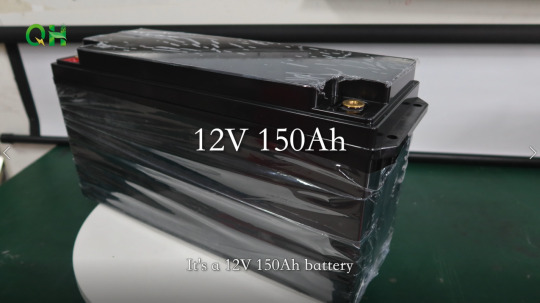

Materials Used:
3.2V 150Ah LiFePO4 battery cells (4 pieces)
There are currently three common shapes of LiFePO4 batteries: cylindrical, prismatic, and pouch. Different shapes of batteries will have a certain impact on performance. At present, the most suitable battery DIY enthusiasts are the prismatic LiFePO4 batteries, which are very suitable for both performance and operational difficulty.
We recommend you purchase the Grade A battery with a high quality and reliable warranty.
BMS (Battery Manage System, 1 piece)
Connectors (About 4pieces)
Others: EVA cotton, screws, ribbon cable, plastic pipes, etc.
Tool Used:
Spot Welder
Spot Welding Pen
Soldering Iron
Wire Cutter
Wire Stripper
Multimeter
Assembly Methods: 4 Series And 1 Parallel
Series(S): The way of connecting the positive and negative electrodes of two different cells is called series connection. As a result, the voltage of the battery pack will increase while the capacity remains the same.
Parallel(P): where the positive and positive electrodes of two different cells are connected in parallel. The result is that the capacity of the battery pack increases while the voltage remains the same.
Assembly Process
1. Place The Batteries
Before we connect this group of battery cells, we should use the multimeter to check their voltage of them to ensure consistency. It is better if you have a testing device to check the internal resistance. Without testing the consistency, the battery pack may cause an accident.
After testing the battery cells, we can arrange our cells as shown in the picture.
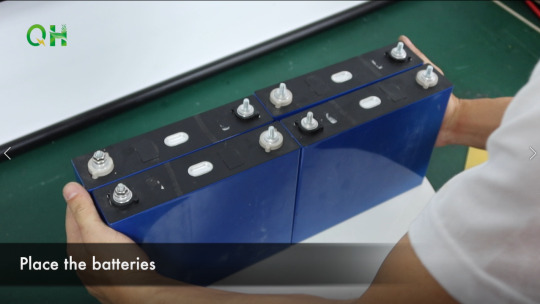
2. Put The Epoxy Board Between The Batteries
What is the epoxy board? The epoxy board is made of alkali-free E-glass cloth impregnated with epoxy resin by processing under heat and pressure. Which have extremely high mechanical strength, Insulation, heat resistance, electrical properties, and good moisture resistance properties. To protect the battery cells, we can put an epoxy board between each battery.
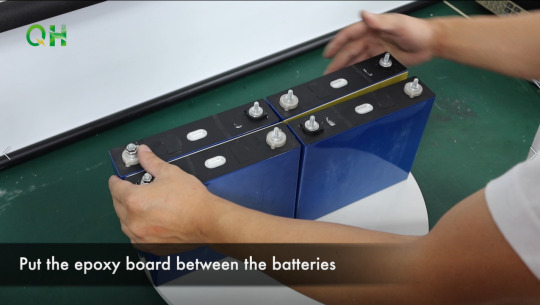
3. Fix Them With Fiber Tape
We place them in order and fix them with fiber tape.
The fiber tape is made of hot melt adhesive and forms a stronger tape that is resistant to tears and has better temperature tolerance than regular tape. It is explosion-proof and leak-proof, providing high-strength insulation protection.
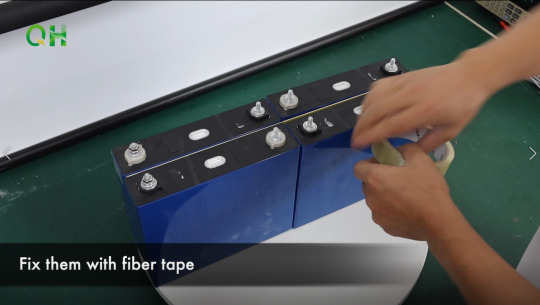
4. Install Signal Acquisition Wires In Sequence With Connecting Pieces
Connect the cells using the connectors in series while connecting the indicator cables to the CPM and the cells. Don’t tighten connectors and nuts too tightly.
When connecting the voltage collection lines (equalization lines), do not connect the external protection board to avoid accidental burning of the protection board.

5. Fix Signal Wires With Screw
Terminal blocks are available as rows, but each terminal connects to only a single wire, which can prevent the loosening of signal wires.
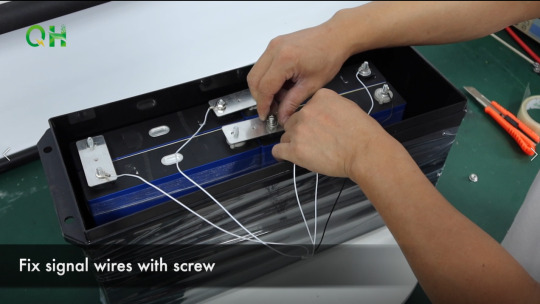
6. Tidy Up The Wires With Tie Straps
After soldering the wires (the balancing leads and the charging-discharging cables), we can tidy up the messy wires.

7. Secure BMS With Thermally Conductive Tape
The thermally conductive tape for battery packs keeps the BMS in place and protects them from the shock of extreme temperature changes.
Besides, these tapes provide electrical insulation, which prevents short circuits and provides a barrier to BMS.
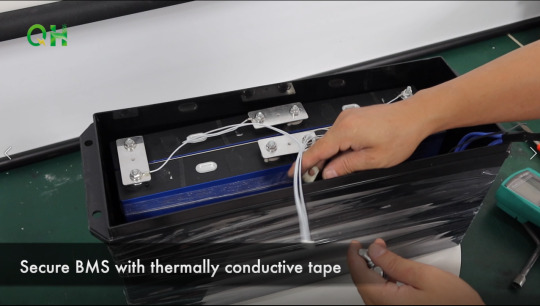
8. Connect B- Of To The Negative Of The Battery Pack
A BMS is one of the most important elements in a LiFePO4 battery, like the brain of the battery pack. It calculates the State of Charge (the amount of energy remaining in the battery) by tracking how much energy goes in and out of the battery pack and by monitoring cell voltages, which can prevent the battery pack from overcharging, over-discharging, and balancing all the cells voltage equally.
There are two main sets of wires we need to install, the thick wires and the thin wires. The thick wires are your charging/discharging wires and the thin wires are your balance wires. Not every BMS is the same, but most are similar. Your BMS will likely have 3 thick wires or 3 pads to solder on your own heavy gauge wires. These are the B-, P-, and C- wires (or pads for adding wires). We usually start with the B- wire. We can connect the B- of BMS to the negative pole of the battery pack.

9. Connect Positive Power Wires To The Battery Pack
If you connect the negative to the ground first then current will flow through the positive terminal to your body when you connect the positive terminal but when you connect the positive terminal first then while connecting the negative terminal the current will pass through the negative to ground wire instead of your body to ground as the resistance of your body is greater than the resistance of wire path and current will always flow through the lowest resistive path. Thus always connect the positive terminal first.
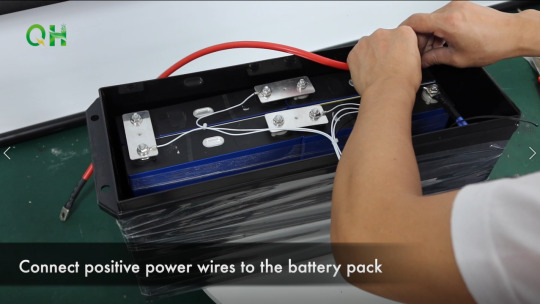
10. Check The Signal Lines In Correct Order
The wrong sequence may cause BMS to burn out!
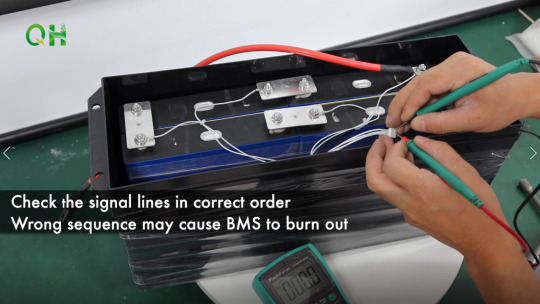
11. Install Positive And Negative Power Lines To The Cap
The total input and output ports of the battery pack are assembled. The assembly of this battery pack is almost done.
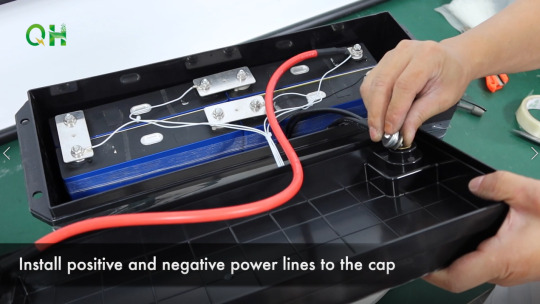
12. Plug Signal Acquisition Wires’ Port Into Interface
The signal acquisition technology can provide accurate parameters for battery balancing, SOC estimation and BMS centralized monitoring to meet the actual requirements of battery packs.
Using the signal acquisition technology, the voltage signal, temperature signal, current signal, etc. In addition, data from the battery pack CAN be transmitted to the central control unit.

13. Fill EVA Cotton
After putting the battery pack into the shells, we can fill the EVA cotton.
EVA cotton can be shockproof, fireproof, and insulated, protecting the battery pack well. It can reduce the expansion force of the battery and improve the service life of the battery.

Battery Tests
1. Voltage Test
In this step, we can use a multimeter to check the voltage of the whole battery pack. Attach the multimeter probes to the positive and negative battery terminals. Then we can check the voltage on the screen. The multimeter’s red probe must be connected to the positive terminal, while the black probe must be connected to the negative one.
A fully-charged battery must indicate a slightly higher voltage than the voltage listed on the battery. For instance, a 12 volts battery will indicate about 12.8 volts when it is fully charged.
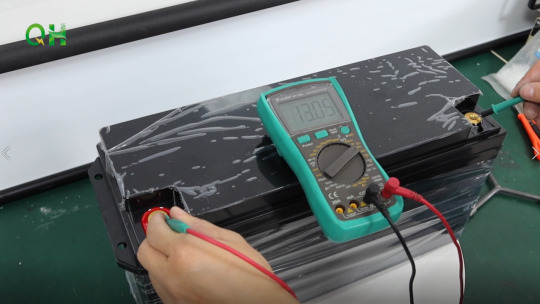
2. Charging Test
The battery capacity, or the amount of energy a battery can hold, can be measured with a battery analyzer. If you’re doing a capacity test, be sure to charge the battery until the battery reaches 100%. Then discharge the device until the battery is fully depleted. The charge and discharge rates of a battery are governed by C rates. The capacity of a battery is commonly rated at 1C, meaning that a fully charged battery rated at 150Ah should provide 150A for one hour. The same battery discharging at 0.5C should provide 75Ah for two hours, and at 2C it delivers 300Ah for 30 minutes.
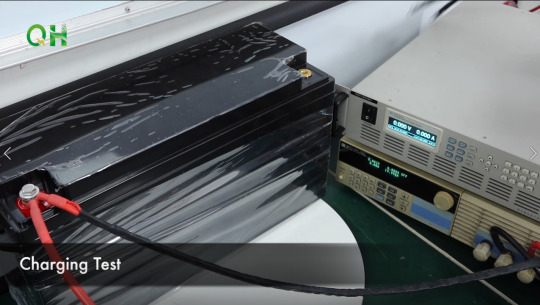
3. Discharging Test
The discharging test of the battery is beneficial to the battery cycle life and discharge performance evaluation. We can use a professional device(Such as a Programmable DC Electronic Load) to check whether the battery works well during the discharging process, which can protect our battery and devices in further daily use.
When testing, there are three factors we need to pay attention to the port voltage of the battery, the resistance of the wire between the battery and the electronic load, and the temperature of the storm.

Summary
Thanks for reading the full tutorial on assembling the 12.8V 150Ah LiFePO4 battery! It is not hard for us to build a LiFePO4 battery. Which voltage and capacity of the LiFePO4 battery do you need? Welcome to share your comment below.
0 notes
Text
Why it is necessary to follow proper safety measures while using Li-Po Batteries?

Due to their unparalleled advantages, lithium-polymer (Li-Po) batteries have quickly become the preferred battery type. The energy density, weight, and discharge rates are all excellent. All facets of RC batteries have been re-invented by LiPo batteries. Despite its useful features, this battery must be recharged with extreme care.
There are many electrical benefits to using LiPo batteries:
LiPo batteries, which can be found in a variety of RC vehicles (cars, boats, and planes), are becoming increasingly common. LiPo batteries are lighter and can store more energy than other types of batteries. Since its inception and subsequent development, it has greatly improved the functionality of radio-controlled vehicles. LiPo 3.7v battery are also used in relatively new vehicle types, such as multi-rotors.
There are numerous functional benefits to lithium-polymer batteries in the realm of electricity. If not handled properly, this particular battery is more susceptible to malfunction. Users need to be aware of certain safety measures in order to get the most out of LiPo batteries.
Power and Potential
It's important to remember that LiPo batteries, when handled correctly, can offer high performance as compared to other types. There are two primary facets of the battery that should be comprehended for safe handling and utilisation. Both of those numbers represent the battery's capacity and voltage. A battery marked "4S-2200," for instance, indicates both the battery's capacity and its voltage as a type of LiPo.
The "4S" indicates that there are four consecutive cells in this structure. The battery has a pack voltage of either 14.8 or 16.8 volts, depending on whether you use the lipo battery 3.7v or 4.2-volt cells. The second figure is the battery's capacity in milliampere-hours (mAh). A fully charged 2200mAh battery can supply a 2200 milliampere-hour current for an hour.
The total capacity of a 3.7v lithium polymer battery remains unchanged regardless of the number of cells used to create it. The capacity rating is helpful because it gives you an idea of how long the battery will last in terms of delivering usable power. However, this data only allows for a very general comparison of batteries in real-world scenarios.
Discharge Rate
The rate at which a LiPo battery drains is another crucial feature. This is a crucial consideration for figuring out what kinds of tasks the battery can handle. The amps the battery can continuously output without being damaged is determined by the discharge rate.
Charger and Operator
No LiPo battery has ever caught fire while sitting in a storage. In most cases, fires caused by LiPo batteries occur while the batteries are being charged or discharged. Most battery issues manifest themselves during the charging process, and the blame can be placed either on the charger itself or on the user. While not always the case, these are the most common causes of fires involving LiPo batteries.
Charging and Discharging Guidelines
When it relates to charging and discharging LiPo batteries, manufacturers typically provide guidelines and warnings. It's crucial to always use common sense and adhere to the battery's charging and discharging guidelines. When it comes to preventing fires and other mishaps, it's best to err on the side of caution. It's crucial to check the battery visually before charging for any obvious damage.
The user or operator should inspect the device for any anomalies, such as a loose or broken connection, frayed wires, swelling, or other abnormalities. A damaged battery should be thrown away because it can no longer be used. A possible explosion and fire hazard exists in charging this battery.
Only the Lithium-balance charger should be used. They should also be very careful to use the battery and charger exactly as instructed. When charging LiPo batteries, it is imperative to workout basic logic and safety precautions at all times. It's not a good idea to leave the batteries unsupervised while they're being charged or discharged because issues could arise.
All users of LiPo batteries should bear in mind these and other guidelines and warnings. Keeping the battery cells from catching on fire or being damaged is simpler if you use common sense and are aware of basic safety measures. There are many great uses for lithium-polymer batteries. These batteries are top-notch, but only if they're used in a risk-free manner.
Email: [email protected]
Phone no.: 86 755 29184180
0 notes
Text
Li-ion batteries (types)
A lithium-ion (Li-ion) battery is a type of advanced battery in which lithium ions play an important role in electrochemistry. During a discharge cycle, lithium atoms in the anode are ionized and separated from their electrons. The lithium ions pass from the anode to the cathode via the electrolyte, where they recombine with their electrons and are electrically neutralized. The lithium ions are small enough to pass through the anode and cathode separator’s micro-permeable separator. Li-ion batteries can have very high voltage and charge storage per unit mass and unit volume due to the small size of lithium (third only to hydrogen and helium).
Lithium-ion battery electrodes can be made of a variety of materials. The most common combination is lithium cobalt oxide (cathode) and graphite (anode), which can be found in cell phones and laptop computers. Other cathode materials include lithium manganese oxide (used in hybrid and electric vehicles) and lithium iron phosphate. In lithium-ion batteries, ether (a class of organic compounds) is commonly used as an electrolyte.
3.7V 2500mAh 18650 lithium-ion battery
The 18650 battery is a Li-ion rechargeable battery with a capacity of 2500 mAh. This is not a standard AA or AAA battery, but it is ideal for applications requiring continuous high current or high current in short bursts, such as cameras, DVD players, iPods, and so on. This 3.7V 2500mAh 18650 lithium-ion battery is environmentally friendly, safe to use, and has long battery life. The 18650 battery has a high energy density and is an excellent continuous power source for your device. It should be used in conjunction with a protection circuit board that protects the battery from overcharge, over-discharge of the pack, and over-current draw.
To use the cell in any circuit, simply solder the wires to the terminals or use 18650 battery holders to replace the used cells. Li-ion batteries must be handled with caution because they are volatile and flammable, and they should not be handled roughly or punctured. Also, do not overcharge or discharge beyond a certain point, as accumulated gasses inside may cause explosions and fires. When using Li-Ion batteries, always use the protection board.

3.7 volt 7000 mAh lithium-ion battery
This is a 3.7-volt lithium-ion battery with a capacity of 7000 mAh. The Li-ion battery is one of the most advanced battery technologies on the market. The primary element in its electrochemistry is lithium ions. Because of its small size, lithium can easily pass through a micro-permeable separator (third in size only to hydrogen and helium). As a result, lithium-ion batteries have a very high voltage as well as a high charge storage per unit of mass and volume.
This 3.7 volts 7000 mAh lithium-ion rechargeable battery is commonly used in GPS, DVD, Tablet PC, Development boards such as Arduino, BBC micro: bit, MP4 Player, Power Bank, Mobile Backup Power Supply, Electric toys, Bluetooth Speaker, IoT, and Industrial applications.

11.1V 5200mAh lithium-ion battery
The 11.1v 5200mAh li-ion battery is one of the most advanced battery technologies available. The primary element in its electrochemistry is lithium ions. Because of its small size, lithium can easily pass through a micro-permeable separator (third in size only to hydrogen and helium). As a result, lithium-ion batteries have a very high voltage as well as a high charge storage per unit of mass and volume.
This 11.1V 5200mAh lithium-ion battery is rechargeable, has low self-discharge, and has high capacity. These batteries have a longer lifespan than standard lithium-ion batteries.

0 notes